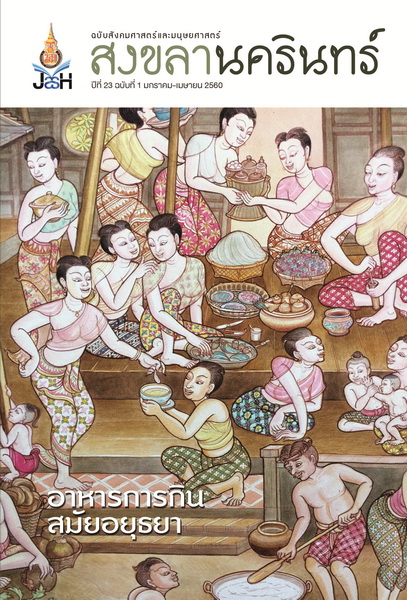<b>การศึกษากลวิธีการเรียนรู้คำศัพท์ภาษาจีนของนักศึกษาสาขาวิชาภาษาจีนคณะมนุษยศาสตร์และสังคมศาสตร์ มหาวิทยาลัยสงขลานครินทร์ วิทยาเขตปัตตานี</b><br> The Study of Learning Strategies in Chinese Vocabulary for Thai Learners in the Chinese Language Program, Fa
คำสำคัญ:
Chinese Language Program, Chinese Vocabulary, Learning Strategiesบทคัดย่อ
The aims of this research are 1) to study the status of Chinese language learning in general, 2) to study
learning strategies in Chinese vocabulary, and 3) to investigate and compare the utilization level of the
learning strategies in Chinese vocabulary among each personal factors for students in the Chinese Language Program, Faculty of Humanities and Social Sciences, Prince of Songkla University, Pattani Campus. Questionnaire with Likert scale is the tool of this study and it is classify into 5 levels which are very frequently, frequently, moderate, rarely, and very rarely. The populations are all the students who currently study for bachelor degree in the Chinese Language Program at Faculty of Humanities and Social Science, Prince of Songkla University, Pattani Campus, and enrolled in semester 2, academic year 2013 (in total 119 students). Statistics used in the study are frequency, percentage, means, standard deviation and comparing the satisfaction by Chi-Square (x2) at 0.05 significant levels were used to analyze the data. From this research, the results shown that the respondents used the learning strategies in Chinese vocabulary for Thai learners at the occasionally level. By using Oxford’s “Strategy Inventory for Language Learning (SILL)”, it was found that compensation strategies, meta-cognitive strategies, and cognitive strategies were the most popular strategies for students used to learn new words. The comparison on the learning strategies in Chinese vocabulary utilization level between males and
females, and group of students with and without background in other foreign languages, shown that
there were no differences. The learning strategies utilization level among the students who currently
study in year 1, 2, 3, 4, and 5 or over, and Group of students with and without background in Mandarin
were different with statistical significance at the 0.05 level in the utilization level of learning new vocabulary, but there are no significant different in utilization level of memorization and utilize new vocabulary strategies. Finally, group of student with and without background in Chinese dialects had no difference of utilization level on using the learning new vocabulary strategies, and memorization strategies, but the level of using vocabulary strategies were different with statistical significance at 0.05 level.
Keywords: Chinese Language Program, Chinese Vocabulary, Learning Strategies
บทคัดย่อ
งานวิจัยนี้มีวัตถุประสงค์เพื่อ 1) ศึกษาสภาพ การเรียนภาษาจีนโดยทั่วไป 2) ศึกษากลวิธีการเรียน
รู้คำศัพท์ภาษาจีน และ 3) ศึกษาและเปรียบเทียบ ระดับการใช้กลวิธีการเรียนรู้คำศัพท์ภาษาจีนของ
นักศึกษาสาขาวิชาภาษาจีน คณะมนุษยศาสตร์และ สังคมศาสตร์ มหาวิทยาลัยสงขลานครินทร์ วิทยาเขต
ปัตตานี เครื่องมือที่ใช้ในการเก็บรวบรวมข้อมูลคือแบบสอบถามที่มีมาตรวัดแบบประมาณค่าตามแนวทาง
ของ Likert โดยมีระดับความคิดเห็น 5 ระดับ คือ บ่อยที่สุด บ่อย ปานกลาง น้อย และน้อยที่สุด ประชากรคือ
นักศึกษาสาขาวิชาภาษาจีน คณะมนุษยศาสตร์และสังคมศาสตร์ มหาวิทยาลัยสงขลานครินทร์ วิทยาเขต
ปัตตานี ที่ลงทะเบียนในภาคการศึกษาที่ 2 ปีการศึกษา 2556 จำนวน 119 คน วิเคราะห์ข้อมูลด้วยค่าสถิติต่างๆ ได้แก่ ค่าความถี่ ค่าร้อยละ ค่าเฉลี่ย ค่าเบี่ยงเบนมาตรฐาน เปรียบเทียบความแตกต่างของระดับการใช้
ระหว่างกลุ่มด้วยค่าไค-สแควร์ ที่ระดับนัยสำคัญทางสถิติ 0.05 ผลการวิจัย พบว่า ผู้ตอบแบบสอบถามมี
ระดับการใช้กลวิธีการเรียนรู้คำศัพท์ภาษาจีนโดยภาพรวมอยู่ในระดับปานกลาง และจากแนวคิดกลวิธีการเรียนรู้ของ Oxford “Strategy Inventory for LanguageLearning (SILL)” พบว่า กลวิธีการเรียนรู้คำศัพท์ใหม่ภาษาจีนที่นักศึกษาใช้ในระดับบ่อย ได้แก่ กลวิธีการเสริมและทดแทน กลวิธีเชิงอภิปัญญา และกลวิธีเชิงพุทธิปัญญา เมื่อเปรียบเทียบระดับการใช้กลวิธีการเรียนรู้คำศัพท์ภาษาจีน พบว่าเพศชายและเพศหญิงและนักศึกษาที่มีและไม่มีความรู้พื้นฐานภาษาต่างประเทศอื่นๆ นอกจากภาษาจีนกลาง มีระดับการใช้ในภาพรวมไม่แตกต่างกัน นักศึกษาชั้นปีที่ 1, 2, 3, 4 และ 5 ขึ้นไป และนักศึกษาที่มีและไม่มีความรู้พื้นฐานภาษาจีนกลางก่อนเข้าศึกษาในสาขาวิชาภาษาจีน มีระดับการใช้กลวิธีการเรียนรู้คำศัพท์ใหม่ภาษาจีนแตกต่างกันอย่างมีนัยสำคัญทางสถิติที่ระดับ 0.05 แต่มีระดับการใช้กลวิธีการจดจดจำคำศัพท์ภาษาจีนและกลวิธีการนำคำศัพท์ภาษาจีนไปใช้ไม่แตกต่างกัน นักศึกษาที่มีและไม่มีความรู้พื้นฐานภาษาจีนถิ่นมีระดับการใช้กลวิธีการเรียนรู้คำศัพท์ใหม่ภาษาจีนและกลวิธีการจดจำคำศัพท์ภาษาจีนไม่แตกต่างกัน แต่มีระดับการใช้กลวิธีการนำคำศัพท์ภาษาจีนไปใช้แตกต่างกันอย่างมีนัยสำคัญทางสถิติที่ระดับ 0.05 กลวิธีการเรียนรู้, คำสำคัญ: กลวิธีการเรียนรู้, คำศัพท์ภาษาจีน, สาขาวิชาภาษาจีน











